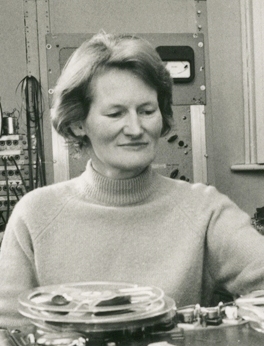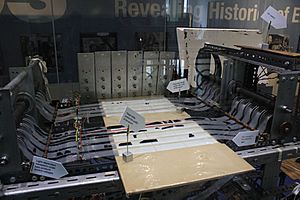Daphne Oram facts for kids
Quick facts for kids
Daphne Oram
|
|
|---|---|
 |
|
| Background information | |
| Birth name | Daphne Blake Oram |
| Born | 31 December 1925 Devizes, Wiltshire, England |
| Died | 5 January 2003 (aged 77) Maidstone, Kent, England |
| Genres |
|
| Occupation(s) | Composer, electronic musician |
| Instruments | Synthesiser |
| Associated acts | BBC Radiophonic Workshop |
Daphne Oram (born December 31, 1925 – died January 5, 2003) was a British composer and musician. She was one of the first people in Britain to create music using electronic sounds. She was also a pioneer of musique concrète, which is music made from recorded sounds that are changed and put together in new ways.
Daphne Oram helped start the BBC Radiophonic Workshop. This made her a very important person in the history of electronic music. She also created a special way to make electronic sounds called Oramics. This method involved drawing directly onto film strips. She was the first woman to set up her own electronic music studio and design an electronic musical instrument. In her book An Individual Note of Music, Sound and Electronics (1971), she wrote about the ideas behind sound and electronics.
Contents
Early Life and Music
Daphne Oram was born in Wiltshire, England, on December 31, 1925. She went to Sherborne School For Girls. From a young age, she learned to play the piano and organ. She also started composing her own music. Her childhood home was near famous ancient sites like Avebury and Stonehenge.
In 1942, Daphne was offered a spot at the Royal College of Music. But she chose to work at the BBC instead. She became a Junior Studio Engineer.
Career Highlights
Working at the BBC
At the BBC, Daphne Oram's jobs included creating sound effects for radio shows. She also mixed broadcast levels. She learned about new ways to make sounds using electronics. She started experimenting with tape recorders after her shifts. She would record sounds, then cut, splice, and loop them. She also slowed them down, sped them up, and played them backwards.
In the 1940s, she composed an orchestral piece called Still Point. This was a very new kind of music. It combined traditional instruments with live electronic sounds. The BBC did not perform it at the time. But 70 years later, in 2016 and 2018, it was finally performed.
In the 1950s, Daphne became a music studio manager. She visited studios in Paris and saw how they made electronic music. She then pushed the BBC to create its own electronic music facilities. In 1957, she made the music for a play called Amphitryon 38. She used a sine wave oscillator and a tape recorder. This was the first fully electronic music score in BBC history.
Because of the growing demand for electronic sounds, the BBC gave Daphne and her colleague Desmond Briscoe money. They used it to set up the BBC Radiophonic Workshop in 1958. Daphne was the first Studio Manager there. The workshop made sound effects and theme music for many BBC shows. This included the science fiction show Quatermass and the Pit.
In 1958, Daphne went to a fair in Brussels. She heard other electronic music artists there. She was not happy that the BBC wasn't focusing enough on electronic music. So, she decided to leave the BBC. She wanted to develop her own music techniques.
Music for Films
Daphne Oram created electronic sounds for the movie Dr. No (1962). These sounds were used in James Bond films until Goldfinger (1964). She was not given credit for her work in Dr. No.
She also added sounds to the short film Snow (1963). After Snow was successful, she worked on another film called Rail (1967). For Rail, she was credited for the "Electronic Treatment (of music)".
Oramics Studio
After leaving the BBC in 1959, Daphne Oram started her own studio. It was called Oramics Studios for Electronic Composition. It was in a converted building in Kent, England.
Oramics is a special way to create sounds. It involves drawing shapes and designs onto 35mm film strips. These drawings are then read by special sensors. The sensors turn the drawings into sounds. Daphne believed that every small detail of music could be made just by changing the drawing. This method gave her a lot of control over how the sounds turned out.

Daphne also needed to make money, so she composed music for many different projects. She made music for radio, TV, theater, and exhibitions. In 1962, she received a grant of £3,550 to help develop the Oramics system. She received another grant in 1965. The first piece of music made entirely by drawing on the machine was called "Contrasts Essonic" in 1963.
Daphne Oram also used Oramics to study how sound affects the human ear and brain. She called her research "commercial Oramics" and "mystical Oramics." She defined Oramics as "the study of sound and its relationship to life." In the 1980s, she worked on a computer version of Oramics.
Books and Writings
Daphne Oram often gave talks about electronic music. Her book, An Individual Note of Music, Sound and Electronics (1971), explores the science of sound. It also looks at how electronic music came to be. A new version of this book was published in 2016.
In the late 1970s, Daphne started a second book. It was called The Sound of the Past - A Resonating Speculation. In this book, she wondered if ancient sites like Stonehenge and The Great Pyramid were used to make sounds. She thought that ancient people might have known a lot about how sound travels over long distances.
Later Life and Passing
In the 1990s, Daphne Oram had two strokes. This made it hard for her to work. She later moved to a nursing home. She passed away on January 5, 2003, at the age of 77.
Her Legacy
Daphne Oram imagined new ways to use sound in performances. Her techniques for changing tape recordings at the Radiophonic Workshop became very important. They influenced many types of music for decades. Her work also helped other artists, like Delia Derbyshire. Delia later helped create the famous Doctor Who theme.
As the creator of Oramics, Daphne helped build the foundation for modern electronic music. She also wrote about the ideas behind music. She thought deeply about how humans connect with sound. In her unfinished book, she wondered if ancient people had a very advanced understanding of sound. Daphne hoped that her work on Oramics would inspire new ideas in the future.
The Daphne Oram Creative Arts Building at Canterbury Christ Church University opened in 2019.
Click Tribute
In 2012, the BBC TV show Click featured Daphne Oram. They talked about her and her Oramics machine. The machine was on display at the Science Museum in London. The show explained that the machine was too old to play. But a virtual version was created so visitors could make their own music. The program called Daphne Oram an "unsung hero" of electronic music.
Daphne Oram's Wonderful World of Sound
Daphne Oram's Wonderful World of Sound is a play about Daphne Oram's life and career. It premiered in Glasgow in May 2017. The play then toured around Scotland. It was written by Isobel McArthur.
The Oram Awards
The Oram Awards were created to celebrate new female artists. These artists work with music, sound, and technology. The awards honor Daphne Oram and other pioneering women in music. The first Oram Awards took place in 2017. Two female innovators received £1,000, and six others received £500.
Publication
- Second edition, 2016, Anomie Publishing ISBN: 978-1910221112
Images for kids
See also
 In Spanish: Daphne Oram para niños
In Spanish: Daphne Oram para niños



